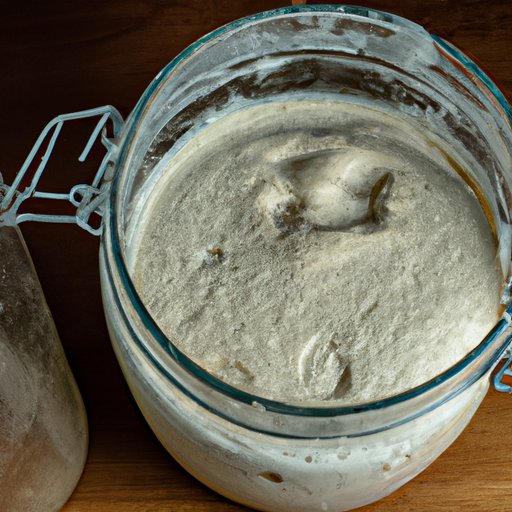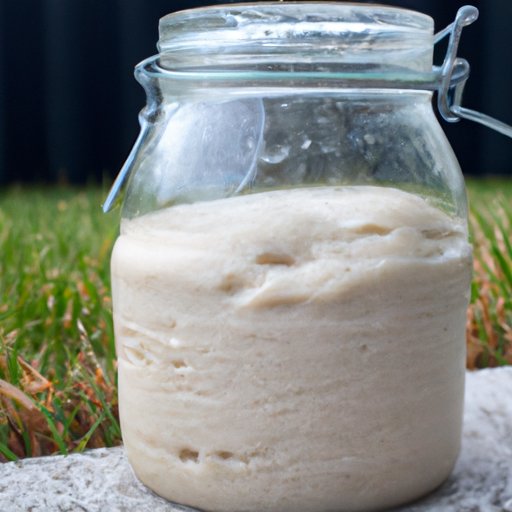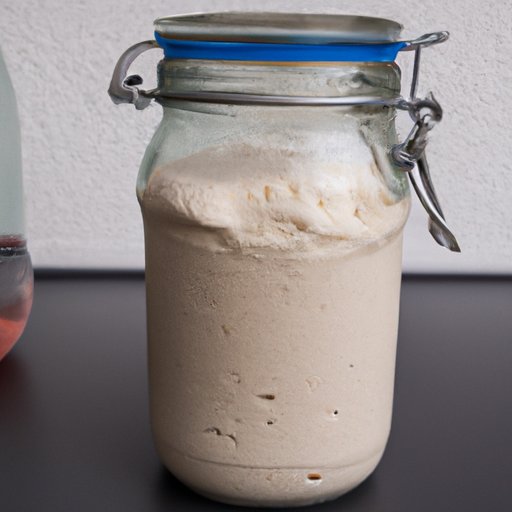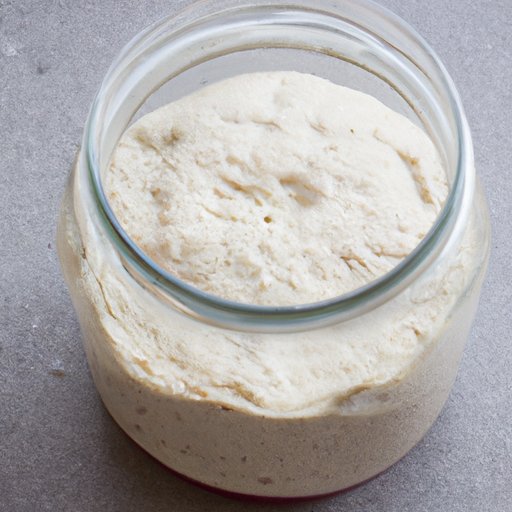Introduction
Sourdough starter is an essential ingredient in many recipes, including bread, pancakes, waffles, cookies, and more. It’s made by combining flour and water, and allowing the mixture to ferment and become “alive” with wild yeast. Making your own sourdough starter from scratch is a great way to add flavor and texture to your favorite recipes. Here, we’ll provide a step-by-step guide to making your own sourdough starter from scratch, as well as some helpful tips and tricks to ensure success.

Definition and Overview of Sourdough Starter
Sourdough starter is a fermented dough that is created by combining flour and water, which allows it to become “alive” with wild yeast. The wild yeast is what makes the starter sour and gives it its unique flavor. It is used in many recipes, including bread, pancakes, waffles, cookies, and more. To make your own sourdough starter from scratch, you will need flour, water, and time.

Benefits of Making Your Own Sourdough Starter
Making your own sourdough starter has several benefits. First, it will save you money since you won’t have to buy ready-made starter mixes or pre-made starters. Second, it will give you full control over the flavor and texture of your starter, allowing you to customize it to your liking. Finally, it’s a fun and rewarding process that will give you a greater appreciation for the art of baking.
Step-by-Step Guide to Making Sourdough Starter from Scratch
This step-by-step guide will walk you through the process of making your own sourdough starter from scratch.
What You Will Need
To make your own sourdough starter from scratch, you will need the following ingredients:
- Flour (all-purpose, whole wheat, rye, etc.)
- Water
Step-by-Step Instructions
- Combine equal parts flour and water in a bowl. For example, if you use 1 cup of flour, use 1 cup of water. Stir until combined.
- Cover the bowl with a damp cloth and let it stand at room temperature for 24 hours.
- After 24 hours, discard half of the mixture and add equal parts flour and water to the remaining mixture. Stir until combined.
- Cover the bowl again and let it stand at room temperature for another 24 hours.
- Repeat this process for 3-5 days, discarding half of the mixture and adding equal parts flour and water each day.
- Once the starter is bubbly and has a sour, yeasty smell, it is ready to use.

How to Easily Create a Delicious Sourdough Starter at Home
Creating a delicious sourdough starter at home doesn’t have to be difficult. Here are some tips to help you along the way:
Tips for Keeping the Starter Alive
Once your starter is alive and bubbly, you need to keep it that way. Here are some tips to help you keep your starter alive:
- Feed your starter regularly with equal parts flour and water.
- Store your starter in the refrigerator when not in use.
- If your starter becomes too thick or dry, add a bit more water to thin it out.
- If your starter begins to smell sour, discard half of the mixture and start again.
Troubleshooting Common Problems
If you’re having trouble creating a successful sourdough starter, here are some common problems and solutions:
- If your starter isn’t bubbling, it could mean that the environment is too cold or too hot. Try moving your starter to a warmer or cooler spot and see if that helps.
- If your starter isn’t rising, it could mean that the flour you are using doesn’t contain enough active yeast. Try switching to a different brand of flour and see if that helps.
- If your starter smells bad, it could mean that it has gone bad. Discard the starter and start again.
An Illustrated Guide to Making Your Own Sourdough Starter
To make the process of making your own sourdough starter easier, here is an illustrated guide to help you along the way:
Visual Aids for Each Step
The following images show each step in the process of making your own sourdough starter:
Helpful Images to Reference
The following images can be used as references while making your own sourdough starter:
A Beginner’s Guide to Making Sourdough Starter from Scratch
If you’re a beginner to making your own sourdough starter from scratch, here are some things to keep in mind:
What to Expect from the Process
Making your own sourdough starter is a slow process that requires patience and dedication. It will take several days to create a successful starter, so don’t expect overnight results. If you stick with it, however, you will be rewarded with a delicious and flavorful starter.
Common Mistakes to Avoid
When making your own sourdough starter, it’s important to avoid common mistakes. Here are some mistakes to watch out for:
- Not feeding the starter regularly. Make sure to feed your starter with equal parts flour and water every day.
- Adding too much or too little flour. Make sure to add the correct amount of flour and water each time.
- Using tap water. Tap water may contain chlorine or other chemicals that can kill the wild yeast in the starter.
Tips and Tricks for Making the Perfect Sourdough Starter
Making the perfect sourdough starter takes practice. Here are some tips and tricks to help you get started:
The Right Temperature and Environment
The temperature and environment play an important role in the success of your starter. The ideal temperature range for fermentation is between 65°F and 75°F. Additionally, the starter should be stored in a dark and draft-free environment.
Flavoring and Adding Ingredients
Once your starter is alive and bubbly, you can start experimenting with different flavors and ingredients. Try adding spices, herbs, fruits, nuts, or seeds to give your starter a unique flavor. You can also try adding different types of flour, such as whole wheat, rye, or buckwheat.
Conclusion
Making your own sourdough starter from scratch is a fun and rewarding process. With the right ingredients, patience, and dedication, you can easily create a delicious and flavorful starter at home.
(Note: Is this article not meeting your expectations? Do you have knowledge or insights to share? Unlock new opportunities and expand your reach by joining our authors team. Click Registration to join us and share your expertise with our readers.)







